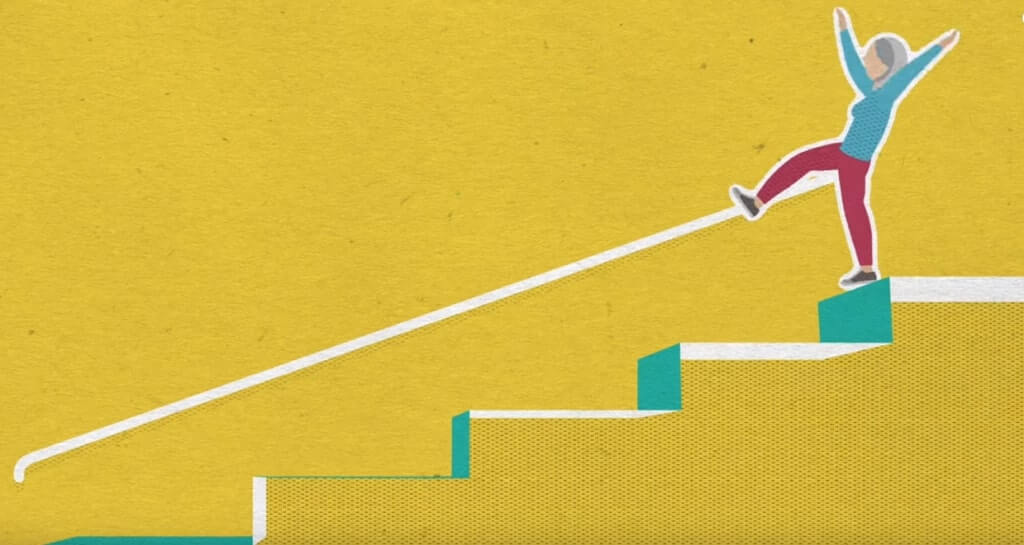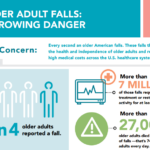
The good news: Falls are preventable. Learn what you can do to reduce the risk of falling.
Falling does not have to be an inevitable (and unfortunate) part of aging. Research shows that most falls are preventable and that seniors can greatly reduced the risk of falling by simply making some basic (and easy) lifestyle changes.
Now, here are the 7 Tips You Need To Know:
1: Keep active. Use it or lose it. In this case, the ‘it’ is balance and strength.
F ocus on exercises that strengthen the leg muscles and improve balance can go a long way toward reducing your risk for falls. If you’re not sure about what types of exercises you should do, talk to your provider. Tai2) Chi3) or Qigong class for example, are proven methods of improving strength, balance4), coordination and flexibility – in a gentle and relaxing way – that can help prevent falls. Water, water workouts, Your local senior center/council on aging, or YMCA are usually good places to look to to find out what programs might be available in your area.2: Talk to your doctor or health care provider about falls on your next visit.
L et your provider know if you have fallen, have a history of falling, or feel unsteady on your feet. If you’ve had instances where you’ve almost fallen, or someone caught you, discuss the details with your provider. You can ask about a Fall Risk Assessment and discuss with your provider. If you are a caregiver for a person or relative who you have concerns about falling, discuss options with the provider.3: Be sure to review your medication list with your provider or pharmacist.
R eviewing medications can reveal contraindications, side effects, combinations that can contribute to dizziness, drowsiness, both of which can contribute to a fall.4: Check your vision at least once per year.
P oor vision is a big risk factor for falling! If you vision conditions such as cataracts, this can also contribute to falling.5: Check your hearing.
H earing loss and inner ear problems can lead to balance issues.6: Check your feet.
Foot problems can result in an unsteady gait or limp. Unconscious compensation (unnatural gait) for foot pain can lead to less steadiness on one’s feet, contributing to falling. Poor fitting footwear or slippery soles are also problematic. High heels, floppies, slippers might not be ideal for your particular challenges. Your provider may refer you to a podiatrist for a through exam.7: Fall-proof your home.
If your home is poorly lit, try to improve the lighting. Clutter is a recipe for tripping. Rugs that aren’t secure can slide and contribute to a fall. Slip resistant backing is a good solution. Slip resistant mat for the shower is a must. Grab bars for the shower/bathtub, or wherever needed. Put non-slip treads or mat strips on stairs. Night lights in the bedroom, bathroom and hallway are always a good idea. A lamp or flashlight within arm’s reach of your bed is also a must. Be prepared for a power outage (and accompanying darkness) by pre-positioning flashlights and battery lamps around your home.Videos
“6 Steps to Prevent a Fall”
Uploaded by: National Council on Aging
Published on Dec. 10, 2015
YouTube.com (Standard YouTube License)
https://www.youtube.com/watch?v=lVkAuF0WSkg
“6 Pasos para Prevenir una Caida”
Uploaded by: National Council on Aging
Published on Feb. 16, 2016
YouTube.com (Standard YouTube License)
“Falls prevention exercises – Older People’s Day”
There’s an underlying myth that falls are an inevitable part of getting old. The surprising truth is our risk of a fall decreases with one thing – exercise.
Here are six simple exercises used by physiotherapists to keep muscles strong and keep us mobile and independent as we age. Try out heel raises, toe raises, heel toe stand, one leg stand, heel toe walking, and sit to stand exercises.
Uploaded by: Chartered Society of Physiotherapy
Published on Sept. 25, 2017
YouTube.com (Standard YouTube License)
Tai Chi
“Tai Chi for Beginners 01 – Tai Chi Fundamentals”
Tai Chi Chuan is a slow moving internal martial art that helps improve our balance and health in many ways. Welcome to Tai Chi for beginners. This first episode is an introduction to Tai Chi Chuan concepts and its first two major movement patterns “Parting Wild Horse’s Mane” and “Brush Knee.”
Uploaded by: Beach TV CSULB
Published on Sept. 27, 2016
YouTube.com (Standard YouTube License)
“Tai Chi for Beginners 02 – Balance and Flow”
Tai Chi Chuan is about balance and flow. In this episode we’ve added the following Tai Chi Chaun movement patterns: “Golden Rooster Stands on One Leg,” “Wave Hands like Clouds,” and “Repulse Monkey.” An emphasis is placed on increasing balance and flow throughout the movements. To learn more from Dr. Daniel Hoover, DC, LAc, MH, please visit his website at SOHMA.org.
Uploaded by: Beach TV CSULB
Published on Sept. 27, 2016
YouTube.com (Standard YouTube License)
Qigong
https://www.youtube.com/watch?v=8kbpS6iJhfY
“Qigong for Balance – 1”
This is the Introduction video for the Qigong for Balance course.
Balance is the ability to maintain an upright structure and is key to fall prevention. This course will explain the importance of balance, causes of falling from different perspectives, and simple exercises and massage practices that improve strength, balance sensitivity, and Qi flow. Join us as we familiarize you with quick and simple ways to improve your balance.
Instructor: Dr. Yang, Jwing-Ming
Uploaded by: Shining Link
Published on Oct. 17, 2016
YouTube.com (Standard YouTube License)
https://www.youtube.com/watch?v=RrBzNHHwnck
“Qigong for Balance – 4”
Balance is the ability to maintain an upright structure and is key to fall prevention. This course will explain the importance of balance, causes of falling from different perspectives, and simple exercises and massage practices that improve strength, balance sensitivity, and Qi flow. Join us as we familiarize you with quick and simple ways to improve your balance.
Instructor: Dr. Yang, Jwing-Ming
Uploaded by: Shining Link
Published on Oct. 27, 2016
YouTube.com (Standard YouTube License)
Resources: CDC
Stay Independent: Prevent Falls
Information for older adults about how to take action and prevent falls.
Download: Stay Independent – Prevent Falls
Older Adult Falls: A Growing Danger
This fact sheet highlights info. about how falls threaten older adults’ health, independence & quality of life.
Download: Older Adult Falls: A Growing Danger
Stay Independent Brochure
Offers a checklist providers and patients can use to check for risk of falling.
Download
Family Caregivers: Protect your Loved Ones from Falling
Brochure for family caregivers with steps to help prevent older adult falls.
Download
Resources: National Council on Aging (NCOA)
-
- 6 Steps to Prevent a Fall Infographic
- Download and share this infographic that outlines 6 easy steps older adults can take to prevent a fall. Also available in Spanish !
- Falls Prevention Conversation Guide for Caregivers Share this guide with caregivers to facilitate a conversation about fall risk factors and empower caregivers to develop a falls prevention action plan.
- Falls Prevention Resource List for Older Adults and Caregivers
Includes links to educational brochures, tip sheets, videos, blogs, exercise and physical activity guidebooks, motivational flyers, success stories, and more. - Falls Prevention Programs: Saving Lives, Saving Money Infographic
Download and share this infographic on the impact of falls among older adults and the benefits and return on investment of evidence-based falls prevention programs. - Falls Prevention Fact Sheet NCOA fact sheet on falls prevention.
- Debunking the Myths of Older Adult Falls Print and share this article with older adults and caregivers.
- 6 Steps to Protect Your Older Loved One from a Fall Print and share this article with older adults and caregivers.
- Osteoporosis and Falls Prevention Share this one-page handout on the link between fall-related injuries and osteoporosis
- Osteoarthritis and Falls For people with osteoarthritis, learn how to lead an active life and prevent falls and injuries.

Sources and References
| ↩1 | (September 22, 2017) Take a Stand on Falls, Centers for Disease Control and Prevention (CDC) . Retrieved October 25, 2018 from: https://www.cdc.gov/homeandrecreationalsafety/falls/adultfalls.html |
|---|---|
| ↩2 | (October 2018) Effectiveness of a Therapeutic Tai Ji Quan Intervention vs a Multimodal Exercise Intervention to Prevent Falls Among Older Adults at High Risk of Falling A Randomized Clinical Trial. JAMA Internal Medicine. Retrieved October 24, 2018 from:https://jamanetwork.com/journals/jamainternalmedicine/fullarticle/2701631 |
| ↩3 | (July 24, 2017) To Prevent Falls, Try Tai Chi New analysis finds this gentle martial art works better than other exercise to keep you steady on your feet , Consumer Reports . Retrieved October 24, 2018 from: https://www.consumerreports.org/exercise-fitness/to-prevent-falls-try-tai-chi/ |
| ↩4 | (October 31, 2013) Balance training seems to prevent falls, injuries in seniors , Harvard Health Publishing. Retrieved October 23, 2018 from: https://www.health.harvard.edu/blog/balance-training-seems-to-prevent-falls-injuries-in-seniors-201310316825 |





